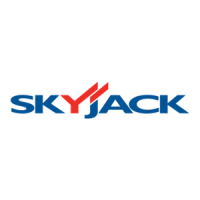SJ 46A & SJ 46AJ
December 2007 Page 65
Section 2 - Operation Tables
Table 2.6 Floor Loading Pressure
lb. kg lb. kg psi kPa psf kPa
14,960 6,786 7,775 3,527 108 745 219 10.5
15,230 6,908 7,775 3,527 108 745 219 10.5
60641AA-ANSI
NOTE:
Foam tires option will add approximately 600 lb. (272 kg) to total aerial platform weight and 150 lb. (68 kg) to max wheel load. OUP will
increase by 4% and LCP will increase by approx 11%.
The LCP or OUP that an individual surface can withstand varies from structure to structure and is generally determined by the engineer or
architect for that particular structure.
OUP
LCP – Locally Concentrated Pressure – is a measure of how hard the aerial platform tire tread presses on the area in direct contact with the
floor. The floor covering (tile, carpet, etc.) must be able to withstand more than the indicated values above.
OUP – Overall Uniform Pressure – is a measure of the average load the aerial platform imparts on the whole surface projected directly
underneath it. The structure of the operating surface (beams, etc.) must be able to withstand more than the indicated val
Gross Aerial Platform Weight = Weight + platform capacity
Standard Configuration = 4WD + Oscillating Axle + 315/55 D20 Air Tires
SJ 46AJ (Standard configuration)
SJ 46A (Standard configuration)
MODEL LCP
Total Aerial Platform Load
Gross Aerial Platform
Weight
Wheel
Tread Contact Area
Width
Length
WARNING
Intermixing tires of different types or using tires of types other than those originally supplied with
this equipment can adversely affect stability. Therefore, replace tires only with the exact original
Skyjack-approved type. Failure to operate with matched approved tires in good condition may
result in death or serious injury.
Locally Concentrated Pressure (LCP):
Foot Print Area = Tread Contact Area
LCP
=
Maximum Wheel Load
Foot Print Area
Overall Uniform Pressure (OUP):
Base Area = Length x Width
OUP
=
Aerial Platform Weight + Capacity
Base Area

